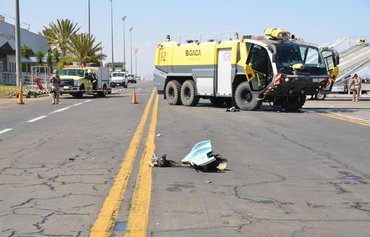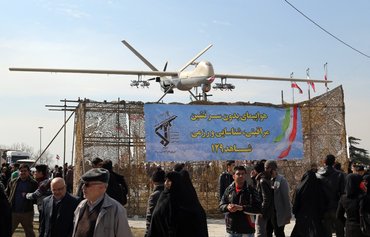BAGHDAD -- Iran-backed militia groups, which have long issued threats against Iraqi Prime Minister Mustafa Kadhemi and have used drones to carry out numerous attacks across the country, are the prime suspects in an attempt on Kadhemi's life over the weekend.
Kadhemi escaped unscathed after an explosives-packed drone hit his Baghdad residence early Sunday (November 7).
The culprits launched three drones from near a Tigris river bridge but two were intercepted, said security sources, adding that the explosion wounded two bodyguards.
Kadhemi gave a brief speech on TV after the attack, saying he had been the target of a "cowardly act of aggression" and that such actions "cannot build a country, nor can they build a future".
A high-level government team with members from ministries and security agencies has begun collecting evidence at the scene of the incident, examining the debris and materials used in the explosion, and determining the drones' launch sites and routes.
"We will track down those who committed yesterday's crime; we know them well, and we will expose their identity," Kadhemi said during a cabinet meeting.
The attack "is not something any brave man would do and does not express the will of the Iraqi people", he added. "There are those who are trying to tamper with Iraq's security and want it to be a gang state, while we want to build a real state."
Sore losers
Hours before the attack, the leaders of factions allied to Iran, including Qais al-Khazaali, the leader of Asaib Ahl al-Haq, and Hadi al-Ameri, the leader of the Badr Organisation, directly threatened Kadhemi.
On Friday, security forces clashed with supporters of Iran-backed parties that lost seats in the October 10 legislative elections. They have claimed to be the victims of vote irregularities.
One person died of injuries in hospital, according to a security source, while dozens were injured, most of whom were members of the security forces.
On Monday, however, Iraq's electoral commission said that a manual vote recount in some polling stations where complaints were filed by pro-Iran groups did not show any "fraud".
Several hundred supporters of pro-Iran groups returned to the edge of the Green Zone on Saturday to protest, and some burned a portrait of the prime minister, whom they called a "criminal".
Iraqi news writer Omar al-Janabi accused Iran axis factions of being behind the attempted assassination of Kadhemi.
The election results and the victors' move to form a new government have provoked those factions to escalate to protests and threats, he said.
The assassination attempt explicitly confirms that the militias will do anything to preserve their corruptly acquired privileges and government positions, as well as their influence and power, al-Janabi added.
The attack shows the armed factions' "unlimited disregard" for peace and stability, and this incident will further isolate them and enrage the public with their harmful behaviour, said Iraqi citizen Khudeir Abbas.
The election losers are capable of anything, said another citizen, Duha al-Shammari.
Drone training base
Iran's Islamic Revolutionary Guard Corps (IRGC) recently set up a new training base in Iraq for members of its regional proxies, with drills focused on launching drone attacks.
IRGC-backed Iraqi militias have launched numerous attacks since April using drones laden with small amounts of explosives, including on July 24, when a UAV targeted al-Harir air base north of Erbil.
At the new base, trainees learn how to operate, fly and develop drones; read aerial photographs; identify the geography of targeted sites; and address other technical matters, said Iraqi political analyst Hilal al-Obeidi.
"The IRGC Quds Force, with help from Lebanese Hizbullah, supervises the camp and provides recruits with courses on drone tactics," he said.
The establishment of the training camp "comes as part of Iran's relentless endeavour to produce a generation of experts with experience in launching explosives-laden drones", he said.
Trying to hide its hand
Iran condemned the attempt to kill Kadhemi, but that denunciation comes as no surprise. Such dissembling is a familiar pattern for Tehran.
Forensic evidence ties Iran to a host of attacks in the region carried out via unmanned aerial vehicles (UAVs), commonly known as drones, even though Iran adopted this modus operandi in part to hide its hand.
Satellite imagery and evidence collected at sites targeted by explosives-laden drones, including facilitates in Iraq and Saudi Arabia, link Iran to the attacks.
Evidence of Iran's role in such terrorist acts surfaced after the hugely disruptive September 14, 2019, attacks that knocked out two Saudi Aramco oil processing facilities in Khurais and Abqaiq.
And in early August, the Pentagon announced that investigations of a July 29 attack on the Mercer Street tanker in the Arabian Sea off the coast of Oman produced clear evidence that Iran was behind the incident.
Iran is directly connected to the attack on the Mercer Street and the preceding attack on the Saudi Aramco facilities, Iraqi military and strategy analyst Alaa al-Nashou said.
Additionally, he said, the Islamic Republic is responsible for continual attacks launched by its regional proxies: the Houthis in Yemen, Lebanese Hizbullah, and Iran-backed Iraqi militias such as Asaib Ahl al-Haq and Kataib Hizbullah.
Drones have become Iran's weapon of choice to threaten regional security, he said, because of their "low manufacturing costs and ability to infiltrate and reach the selected targets".
While Iran attempts to hide its hand by using such weapons, he said, international investigations and evidence recovered from the crime scenes confirm its involvement.
Iran is "equipping its proxies with the components of these aircraft and providing them with expertise and advice on how to assemble them and training on operating them", he added.

![Protesters tied to Iran-backed groups burn portraits of Prime Minister Mustafa Kadhemi and security officials on November 6, a day before a failed attempt on Kadhemi's life. [Ahmad Al-Rubaye/AFP]](/cnmi_am/images/2021/11/08/32502-iraq-kadhemi-attack-600_384.jpg)






